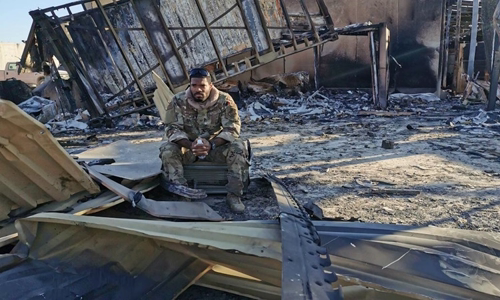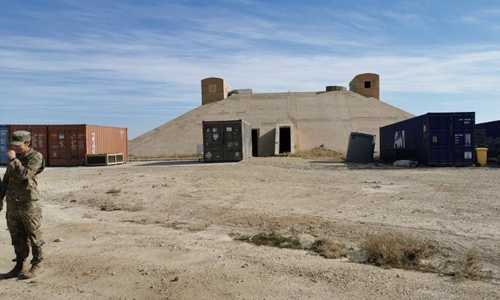Akeem Ferguson was in a bunker when his team received a radio announcement: 6 Iranian ballistic missiles were directed at them.
"I gripped my gun, bowed my head and tried to think about happy things. And then I imagined I was singing to my daughter," sergeant Ferguson recalls. "I keep waiting. I hope no matter what, it will happen quickly."

Akeem Ferguson sits amid the wreckage at al-Asad base after Iran's January 8 missile strike Photo: CNN
"At that time I was ready to die," he added.
Ferguson, along with US soldiers and other civilian contractors at the Ain al-Asad base in Anbar province, western Iraq, survived a missile strike from Iran early on January 8 to avenge the U.S. air strike. killed General Qassem Soleimani.
The attack is Iran's most powerful counterattack on an American garrison for decades. The soldiers here said that their forces did not suffer any casualties during the raid like a "miracle".
US troops present at al-Asad base are tasked with fighting the Islamic State (IS) rebels and training Iraqi security forces. As one of the largest and oldest military bases in Iraq, al-Asad has no air defense system capable of dealing with ballistic missiles, so everyone here has to go down to the bunker immediately. upon receiving the warning of the attack hours ago.
Near the airport in the base, metal fragments sprawled under the feet of two soldiers as they examined the crater about two meters deep, nearly three meters in diameter, where an Iranian short-range ballistic missile descended. Next to the crater was the scorched "Beauty and the Beast" story, a flip-flops, Uno card and an army jacket poking out from the rubble.
The area is home to unmanned aerial vehicles. They also evacuated prior to the raid. Like most other Americans at the base, they entered the bunkers more than two hours before the first missiles fired.
The Iranian ambush did not cause casualties, so many people breathe a sigh of relief. At al-Asad base, the soldiers were able to rest comfortably after several days of intense alarm. For countries in the region, it marked a step down the tensions ladder between the US and Iran after the killing of Soleimani. The risk of war therefore also receded.
10 of the 11 Iranian missiles landed in the area near where US troops were stationed at the base. The remainder fell into uninhabited areas under Iraqi rule. Americans control about a third of al-Asad.
The first warning of an Iranian ambush came from secret intelligence on Saturday night. By 11:00 PM that night, most of the US troops in al-Asad went down to the shelter, according to the base commander.
Only soldiers at important positions such as watchtowers or unmanned aircraft pilots will continue to hold on to the location of the mission. They stayed behind to defend the base from a ground attack that, according to the commanders, could take place after the missile strike.
However, no ground-based attack took place after the missile strike ended just before 4:00 in the morning. The soldiers began to leave the bunker at dawn.
Iraqi Prime Minister Adil Abdul Mahdi said Iran had alerted him at midnight of the attacks. An Arab diplomat revealed that the Iraqi side then transferred this information to the US.
But the United States received a report of a potential missile attack before Iraq had reported it, according to Lieutenant Colonel Tim Garland, commander at al-Asad base.
The first missiles dropped at 1:34, followed by three other waves, each spaced over 15 minutes apart. The attack lasted for more than two hours. The soldiers described them having experienced a period of fear and suspense because there was nothing they could do to combat the "rocket rain" pouring down.

The bunker since Saddam Hussein's time at al-Asad base Photo: CNN
"You can resist the militant forces attacking the base, but you can't deal with this," said Captain Patrick Livingstone, commander of US Air Force security forces in al-Asad. to previous rocket attacks from rival armed forces. "Currently, the base is not designed to defend against missiles."
The underground bunkers of American soldiers had a pyramid-shaped structure scattered throughout the base. They date back to Saddam Hussein and also used to fend off missile attacks from Iran during the 1980-1988 war.
US soldiers said they were unsure whether the bunker from Saddam's time could withstand ballistic missiles, but they were clearly stronger than American concrete fortifications, which could only withstand rockets. and mortar. Iranian missiles have a longer range and carry much larger explosives, at least half a ton each.
Lieutenant Colonel Staci Coleman was one of the commanders who led the soldiers into the bunker. After about an hour and a half, she started to feel suspicious.
"I sat in a shelter bunker and thought if I was making the wrong decision," Coleman said. "About 10 minutes after I asked myself, booms, booms, booms and noises continued. That's the answer."
"The ground shook. The explosion was very loud," she recalled. "You can feel the shockwave from below the shelter. We know the rocket is very close to us."
In the end, no bunker from the Hussein period was diluted by Iranian missiles.
Meanwhile, Ferguson held his breath hiding under a US-built concrete fort, a cramped space built of 12 cm thick concrete slabs and reinforced with sandbags. He watched the attack through cracks in the walls.
"Every flash of fire came with a bang. We didn't know when they would end. We just sat and waited," he said.
When the rocket stopped falling, all the soldiers left the bunker, many returned to their work positions, others went to repair the damaged areas. They were both relieved and shocked.
"Everything is fine after all. But we look into each other's eyes as if to ask 'are you okay?'" Coleman said.
Some say this incident has changed their perception of war. The US military has rarely become the target of sophisticated weapons, even though it launched the world's most advanced attacks.
"You look around and think: Where are we going to run? How to get out of here?" "I don't expect anyone else to experience that kind of fear. Nobody in the world should experience that feeling."



 NikkiDarling
NikkiDarling







